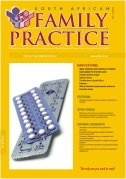Pattern of Depression among Patients in a Nigerian Family Practice Population
Keywords:
Depression, Nigerian, Family Practice, Population
Abstract
Background: This study determines the pattern of depression among patients attending the Family Practice Clinic at Wesley Guild Hospital, Ilesa, Nigeria. Socio-demographic and clinical correlates associated with depression were identified. Methods: Two hundred and fifty (250) newly registered patients who attended the clinic between June and September 2005 were selected by the systematic random sampling method and studied. Relevant data were collected using a pre-tested interviewer-administered questionnaire that incorporated Zung’s Depression Scale. Results: The age of the study subjects ranged from 16 to 84 years, with a mean age of 49.66 + 14.95 years. One hundred and forty-nine of the 250 subjects (59.6%) were found to have one form of depression or the other. Of these, one hundred and seven (42.8%) had mild depression, forty (16.0%) had moderate depression and only two (0.8%) had severe depression. Depression was found to be commoner in the age groups from 45 years and above, and there was a significant association between age and depression. There were 74 males and 176 females in the sample population, showing a male to female ratio of 1:2.4. Out of 149 depressed subjects, one hundred and four females (69.8%) had depression, while depression was present in 45 males (30.2%). Forty-seven (87.0%) of 54 subjects with no formal education had depression, while depression was found in 102 (52.0%) of the 196 educated subjects. Low educational status was significantly associated with depression in this study. Only two (0.8%) of the 250 subjects gave a positive family history of psychiatric illness, and these two subjects had mild to moderate depression. The proportion of depressed subjects who lived below the poverty level was significantly greater than that of non-depressed subjects. Substance use was also significantly more common among depressed subjects than the non-depressed group. Conclusion: The proportion of patients with depressive symptoms in family practice clinics is high, and it is highly correlated with socio-demographic factors and low socioeconomic status. Family physicians are hereby enjoined to pay greater attention to patients with these factors, as they are at increased risk of depression. In order to reduce the high proportion of depressive symptoms and its adverse impacts on patients seen in family practice clinics and in the community as a whole, there is a need for effective implementation of poverty-alleviation programmes and universal basic education.
Published
2008-02-28
Section
Original Research
By submitting manuscripts to SAFP, authors of original articles are assigning copyright to the South African Academy of Family Physicians. Copyright of review articles are assigned to the Publisher, Medpharm Publications (Pty) Ltd, unless otherwise specified. Authors may use their own work after publication without written permission, provided they acknowledge the original source. Individuals and academic institutions may freely copy and distribute articles published in SAFP for educational and research purposes without obtaining permission.

